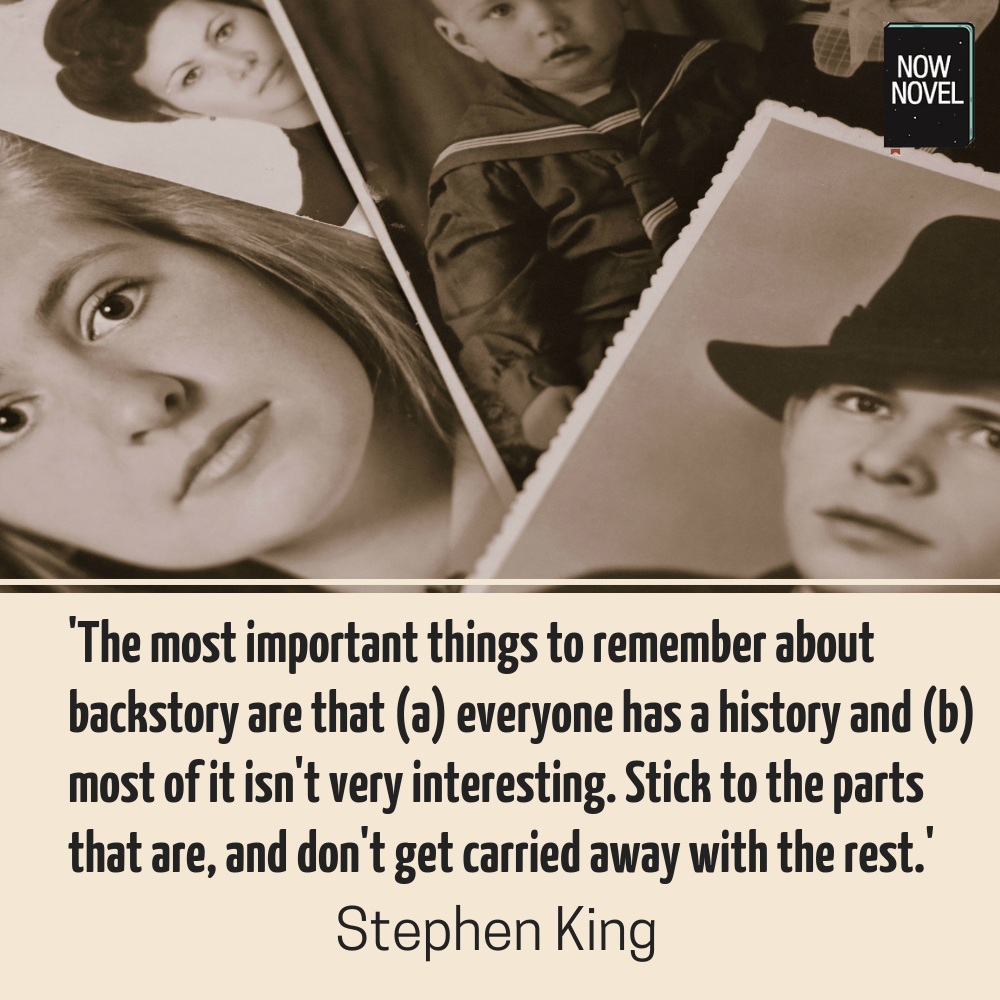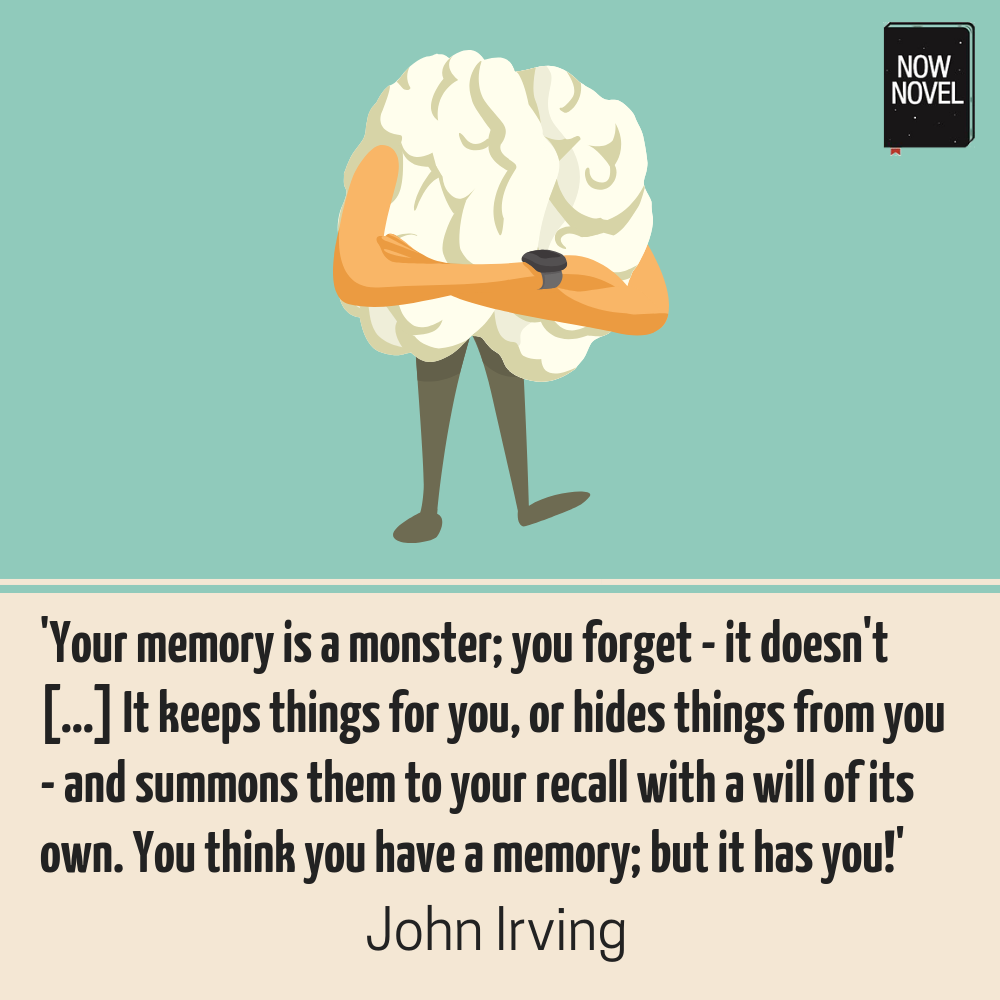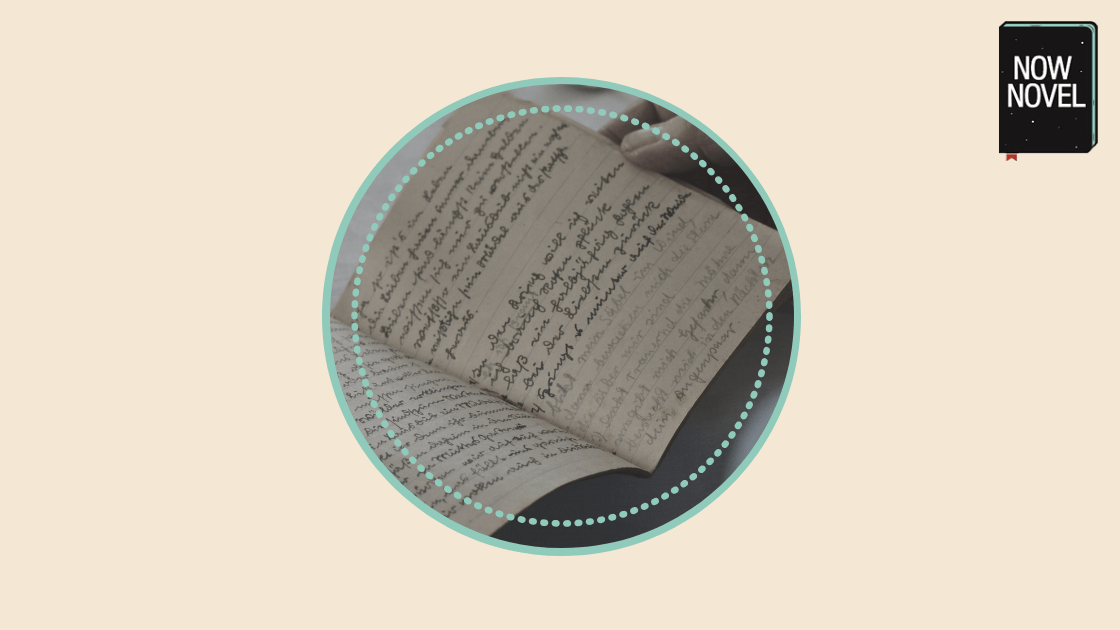Character backstory – the past events and formative experiences that shape who your characters are – is key to creating characters of breadth and depth. Here are tips to weave backstory into your story believably:
First: What is a backstory?
‘Backstory’ is a literary device authors use to give characters and their story arcs a sense of history. Backstory is the imagined pasts characters’ lives and worlds possess. These events take place before the main narrative of the story.
What are the uses of backstory in storytelling? There are several:
- Developing readers’ understanding of characters. For example, gradually revealing a character’s traumatic past could give the reader context (over time) for the choices a character makes or the fears they carry with them
- Backstory can raise stakes (for example, if we learn a character has battled for years with addiction, the appearance of temptation becomes more suspenseful)
- Backstory gives characters psychological realism: Ms Havisham’s cynical view of love (and her efforts to turn her adopted daughter against it) in Charles Dickens’ Great Expectations makes more sense when we find out she was once jilted by a husband-to-be
So how do you make backstory feel real?
1: Show how backstory affects your characters’ present
This may seem obvious – that a person’s past affects their present. Yet often beginning authors will dwell on events in a character’s life without revealing sufficiently why they are significant to the current narrative.
When creating a character profile (which you can do in the Character section of Now Novel’s step-by-step prompt process), ask:
- What events from the past may affect my character now, physically?
- How have past events shaped my character emotionally?
- What past situations have led my character down the road they’re on?
- What were their big choices and how do they feel about the route they chose?
To take an example, in Fyodor Dostoevsky’s classic novel Crime and Punishment (1866), the anti-hero, a penniless student indebted to a stingy pawnbroker, decides to murder and rob her.
At the start of the story we learn that the student, Rodion Raskolnikov, had to discontinue his studies. He struggles to make rent and he is too ashamed to ask his family for more money. From the start of the novel, Rodion’s backstory of events include career disappointment, defeat and shame. These, coupled with Rodion’s fragile mental state, explain how he gets to the desperate state of being capable of murder.
To make backstory feel real, think about these many branches of a person’s life and history. Physical health. Psychological health. Economic means. How do each of these elements shape a person’s life? What events and memories pull some of your characters’ strings?

2: Use backstory to shape character development
Character development is a vital aspect of a believable story. When characters are one-dimensional and predictable, they’re hard to believe. How can backstory help with character development? We are all products of both nature (ingrained personality traits) and nurture (our past experience and how we respond to it).
The significant events that have happened to us throughout our lives both for better and for worse have shaped us. Characters like real people may carry all kinds of experience with them, such as:
- A happy, loving childhood
- An abusive ,cruel one
- Lost loves
- Inspiring mentors
- Smaller and larger triumphs
- Smaller and larger defeats
Imagine significant past events each character’s life. Given their possible associations, what new experiences might trigger:
- Fear?
- Comfort?
- Nostalgia?
- Anger?
- Retreat?
Place characters in situations that trigger their past struggles (or, in positive cases, echo the fondest memories they want to live again). Repetition and change are two key aspects of backstory. What lessons is your character doomed to repeat, not having learned the first time? And how do they break the mold of the past?
As interesting as backstory is, make sure to balance backstory with the main, present events of your story:
3: Make sure your main story arc stays in focus
Toni Morrison’s profound, distressing, but beautifully told novel about the effects and remnants of slavery Beloved (1987) is rich with character development.
Morrison’s narrative circles around a terrible choice her protagonist Sethe makes to avoid her child having to grow up suffering as she did. Yet Morrison begins her story with her characters’ present family relationships and struggles.
She starts by showing their ordinary lives, describes the boys of the house leaving the home, and the loves of the characters who stay behind.
By keeping the main, present-time story arc in focus, Morrison shows how people somehow manage to keep living despite unimaginable suffering. She uses backstory to achieve multiple things:
- Her characters’ histories are raw, real events that animate their present, even if these events have not yet been told in full
- Morrison shows the complex ways history – both personal and social history – and the present day intertwine, through her characters’ conversations and memories and how these circle back to the past
Morrison begins her novel with the simple three words ‘124 was mean’. We learn that this is the address of Sethe’s family home, the setting for the heartbreaking choice we eventually learn. It’s only over the course of the story that we learn why the house is mean and ‘full of a baby’s venom’. The past comes to us slowly as the present story unfolds. This gives characters’ haunting memories and pain a believable quality of traumatic suppression and return.

4: Create character backstories without clumsy info dumps
Part of the struggle of writing is backstory is deciding how to include it. It’s important to avoid the info dump as you reveal character backstory.
An ‘info dump’ is when the author writes information for the reader’s benefit so that it is transparent this is its purpose. You could compare this to seeing the magician’s rabbit being sneaked into the hat. When we see the literary device as a literary device, it loses its magic.
There are other ways to integrate backstory into your main story. Here are a few tips and techniques for doing so:
- Use diaries, journals, or other secondary sources to give the backstory. Margaret Atwood does this in her Booker-winning novel The Blind Assassin (2000). She includes extracts from her protagonist’s deceased sister’s fiction between the chapters the living sister narrates. These ‘story within a story’ sections give us direct insight into the late sister’s mind and interests; into her world view.
- Dramatize your backstory. A flashback scene, dream sequence or piece of dialogue where one character simply tells another what happened can be effective. Remember to avoid dialogue where characters recap information both know, purely for the reader’s benefit
- If you are dramatizing your backstory, give it a believable trigger. It’s might read oddly if characters just keep having vivid dreams and flashbacks at any point in the story. Vivid dreams, memories and recollections often begin with associations. For example, a character looking through a family photo album that brings back strong memories might have detailed dreams of a childhood event the same night
5: Pace how you release characters’ backstories
Reveal bits of backstory little by little. You can even use this technique to create stronger suspense for your reader as they wait to learn more about a character’s mysterious past. For example, if a character keeps dreaming of a mysterious object, later chapters could gradually reveal how the object links to key past events.
Releasing backstory more gradually makes it believable as it doesn’t feel like a chunk of events the author is simply trying to get out the way.
Need feedback on a flashback scene or other backstory writing? Join Now Novel for constructive feedback from the community.


20 replies on “Writing character backstory that feels real: 5 tips”
Thanks for the enlightening article regarding backstory. I’ve really been struggling with the backstory , worrying how to tell the story with out the past consuming the present. I’ve always had issues with the correct tense when going between backstory and present tense. I have soooo much to learn about the writing craft. Thanks for your help. I don’t take advantage of it enough but I intend to in the future. Enough of ‘going it alone’ during the writing process. I need all the help I can get!
Excellent, glad we can help Cheryl. If there is a particular areas you’d like us to write about please let us know.
This actually helped me so much! ?
Hi Chloe,
I’m really glad to hear that! All the best for your writing. – B
This helped me too 🙂
Glad to hear that, Hailey. Thanks for reading.
Thank you for this! I have a superhero task at school where I have to create a superhero, and one of the missions is to write a backstory. I’m a bit stuck because I have many ideas but I don’t know which one to pick to make it work.
I hope you got top marks for your school task! Thanks for reading.
Thanks! This helped me so much!
Hi Tùy, thank you for reading and giving us feedback, I’m glad we could help!
I am a beginner at writing books but I love to write but I was a bit confused on where to add the backstory this makes so much sense.
Hi Makhia, that’s great to hear. Good luck with your story!
If i talk about a character that has lost her parents (which she thinks its her fault) but its not too important to the story, does that count as info dump?
Hi Jaylynn, thank you for your question. I would say not necessarily. It would depend how this information is presented in the story.
Provided the information is revealed at a moment relevant to the action or the character’s thoughts, it wouldn’t be an info dump. Info dumps are a lot of telling information given at once without any connection to a sense of scene, place and time. If, for example, your character found an old photo album, or there were another action related to her parents, this would be a good moment to show her memory of them and reveal the fact they’re deceased as it ties the information to her emotion and to the action in that moment. The connection, the relevance, is clear.
I hope this helps!
[…] to your characters past, you can hint at a much larger (and fuller) history… without having to plant infodumps all over your […]
[…] with backstory feel like real people who existed before the story. They had rich, full lives – or maybe desperate, empty […]
[…] of the readers. So, unless you have a good reason for withholding important information, providing backstories to characters is a must, especially in writing […]
When working on a villain’s backstory, any advice?
Thank you for your question, Katie. I would say:
I hope this helps! Good luck.
[…] According to a post on https://www.nownovel.com/blog/talking-character-backstory/ […]